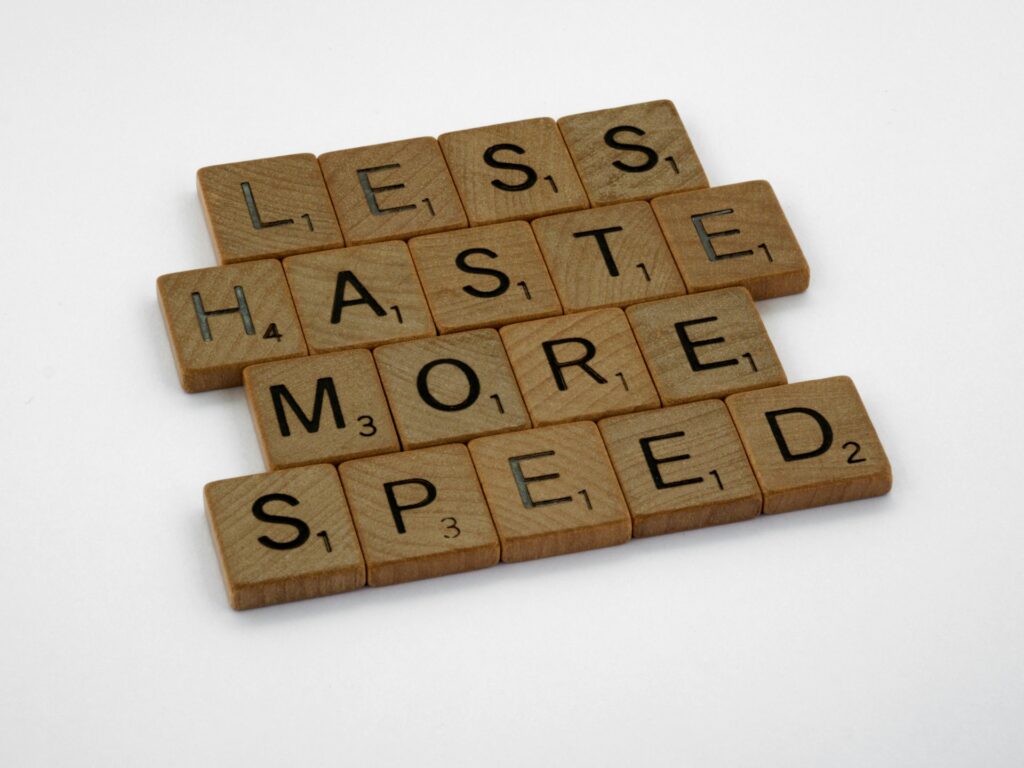Research teams are working faster than ever. With the help of AI tools, automation, and more efficient workflows, it is now possible to deliver insights in hours rather than days. For time-pressed teams and clients, this can feel like a significant step forward.
However, as research accelerates, it introduces a new set of challenges.
How can quality be maintained when everything is moving quickly? What should be protected? What should be prioritised? And what are the quieter risks that come with operating at a constant pace?
It is widely understood that the faster something moves, the greater the risk of errors or shortcuts. Research is no exception. The opportunity to get more done in less time is appealing, but it can lead to superficial findings, simple mistakes, and the introduction of poor-quality data into the mix.
This guide is designed for teams who are embracing speed and the benefits of AI, but want to remain thoughtful.
Ultimately, consider this not a call to slow down. Instead, it is a practical resource for identifying where to pause, when to go deeper, and how to ensure the work remains useful, not just efficient.
Good Data In = Good Data Out = Good Results.
The Acceleration Is Real
It is no longer surprising to hear that a full research project, from discovery to reporting, can be completed in just a few days. AI-assisted tools can now cluster themes, transcribe meetings, summarise open-ended responses, highlight sentiment shifts, and even produce draft reports. Tasks that once required hours of human input can now be automated or significantly sped up.
This shift is not only technical. It is also cultural. Faster research has become the norm, and with it comes a quiet but noticeable shift in expectations. Clients are asking for next-day toplines. Teams are being asked to manage more briefs. A turnaround that used to feel tight is now seen as standard.
For many, this has brought genuine benefits. There is less time spent on manual tasks, fewer hours formatting data, and less need to trawl through transcripts. These tools can create much-needed breathing space. The important question is how that space is being used.
Some of the ways that AI can be used to improve speed when it comes to research are:
- Transcription & meeting notes
- Thematic clustering
- Surface-level sentiment analysis
- Drafting toplines or first-pass summaries
- Automating repetitive formatting or tagging
Some teams are choosing to use it for reflection, interpretation, or quality control. Others are using it to absorb more work, deliver more outputs, and operate at a faster pace than ever before. The tools may have evolved, but the outcomes depend entirely on how we use them.
More Output, or Better Output?
Once a process speeds up, the natural response is to do more of it. If a topline can now be drafted in a day, the expectation may quietly shift: from one project a week to two. More debriefs. More deliverables. More output.
But more is not always better.
Consider what often gets lost when pace takes over:
- Time to sense-check findings
- A second look at outliers or contradictions
- The space to dig into one audience’s motivations, not just summarise their responses
- The team huddle where someone says, “Have we actually answered the brief?”
These moments are often where real insight begins.
AI has taken the pressure off certain tasks, particularly admin-heavy ones. But the saved time should be reinvested in quality, not immediately filled with extra work.
The most thoughtful researchers use that time to:
- Look deeper at patterns in the data
- Stress-test conclusions before presenting them
- Consider what is missing, not just what is there
- Think about what the client is really trying to decide
It is easy to confuse activity with progress. Delivering more slides does not always move thinking forward. Insight is not measured by how quickly a report is written. It is measured by whether it helps people make better decisions.
The Risks of a Speed-First Culture In Research
Working quickly is not inherently a problem. Many research teams thrive under pressure. The challenge arises when speed becomes the priority, not just a by-product of better tools, but the measure of success.
This is when quality can begin to slip, often in subtle ways:
- Outputs start to feel templated. When every report follows the same structure, the nuance of the audience or category can get lost. Relevance is replaced by repetition.
- Analysis becomes a summary. Instead of interpreting what the data means, teams may begin to describe what it says, without going further. A list of themes is not the same as an insight.
- Junior researchers miss development opportunities. If AI or templated tools are doing most of the work, there is less hands-on experience in thinking through the messy, uncomfortable parts of the work, which is often where confidence and judgement are built.
- No one asks awkward questions. When things move fast, there is less space to pause and challenge. Does this finding make sense? Are we missing anything? Is this even useful?
These risks do not appear all at once. They appear slowly, in small ways.
A deck that lands flat.
A client who does not follow through on recommendations.
A sense, within the team, that something is missing, but there is no time to figure out what.
Pace is powerful, but it needs boundaries. Without them, speed becomes the goal, not the enabler.
A Practical Guide for Balancing Speed and Depth
Working quickly doesn’t mean compromising quality. The best research teams use speed to their advantage, but they do so intentionally. Below is a set of simple checks and habits that help protect depth, even when the pace is high.
Checks Before You Press Send
One way to stay grounded is to build in short but meaningful checks. These can happen at the end of a sprint, before a debrief, or even mid-project. Before anything goes out the door, ask:
- Does this align with what we actually saw?
- What are we not saying, and why?
- Would we be confident defending this in front of a client who knows the data better than we do?
If the answer to any of those is “I’m not sure,” it is worth another look.
What Quality Looks Like in an AI-Powered Team
If your team’s speed is increasing (and that is often a positive thing), this is when depth needs more conscious protection. That might mean:
- Inspecting and checking AI outputs before they reach a client document
- Asking “What’s missing?” instead of just “What’s here?”
- Training researchers to interpret, not just summarise
- Making time to explore the awkward, unstructured bits. These are the bits that do not fit neatly, but might hold the real answer.
These choices do not disappear because the tools have changed. If anything, they matter more. The difference between your team and another agency may not be the technology used, but the time taken to dig deeper and care about what the results mean.
Use Speed to Improve Research, Not Just Increase Volume
Saved time can be used for better thinking:
- Add a sense-checking step to every action
- Encourage team discussions around what surprised them in the data
- Pause before recommending. Ask if the answer is clear, or just fast
Choose When to Go Deep And Make That Clear
Not every brief needs a three-week process or a 60-page deck. But some questions do deserve more than a fast turnaround. Be deliberate about where your team slows down, and help clients understand why that matters. But there are moments when a fast turnaround risks missing the point.
Certain briefs carry more weight. They may involve strategic business decisions, unfamiliar audiences, ambiguous findings, or high stakeholder visibility. In these situations, the value of the research comes not from how quickly it’s delivered, but from the thought that goes into it.
When these cases arise, it’s worth being explicit to your client about why your team is slowing down. That might mean:
- Flagging early when deeper analysis is needed
- Building in time for stakeholder alignment
- Allowing space for synthesis beyond surface-level themes
- Acknowledging ambiguity rather than rushing to a conclusion
Framing this clearly for clients is key. When you choose to slow down, explain why. For example, you might say:
- “We’ve identified some conflicting themes that need deeper exploration before we draw conclusions.”
- “Given the strategic importance of this decision, we’re allowing more time for interpretation.”
- “There’s a gap between what people are saying and what they’re doing, and it’s worth unpacking in a bit more detail.”
These signals help manage expectations and show that the added time is intentional, not a delay.
This is not about inflating timelines but simply protecting the quality of the output while aligning expectations.
Being fast is valuable. But knowing when to pause and being able to explain why is what sets experienced teams apart.
Fast Can Still Be Considered
The tools we use have changed. The pace of delivery has changed. In many ways, that is a good thing. Less time spent on manual tasks means more space for strategic thinking. Faster workflows can reduce friction and improve responsiveness.
However, speed alone is not a strategy.
Insight still relies on interpretation. It still needs time to ask the right questions, to notice what is missing, and to connect the dots in a way that makes sense to the client. The ability to move quickly is useful. The ability to pause when it matters is invaluable.
Balancing speed with depth is not about resisting progress. It is about protecting what makes research useful in the first place. The thought. The judgement. The care.
Move fast when you can. Slow down when you should. And remember, clarity is not always a by-product of pace. Sometimes, it is the result of choosing to look a little closer.
If you’re rethinking how your team can balance speed with substance, now’s a good time to explore the tools that make it possible.
Aida by Beings.com helps research teams speed up so they can get that depth.
From faster transcripts to instant theme clustering and smart, structured summaries, Aida supports high-quality insight without slowing you down.
Try it for yourself and see how speed and depth can work together.



